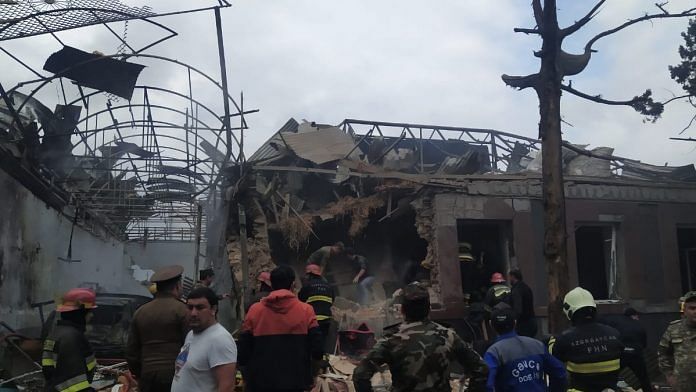New Delhi: On Monday, Armenia accused Azerbaijan of firing missiles into the capital of the Nagorno-Karabakh region, a disputed territory located in between the two countries, while Azerbaijan said several of its towns were attacked and its second-largest city, Ganja, was “under fire”.
In the past week, Nagorno-Karabakh has once again become the site of air and artillery attacks between Armenia and Azerbaijan. Clashes between the two countries erupted
on 27 September for the first time in almost 30 years after which Armenia declared martial law and ordered the total mobilisation of its military. It claimed to have shot down several Azerbaijani aircraft and tanks and accused its neighbour of attacking civilian settlements in Nagorno-Karabakh’s regional capital, Stepanakert. Meanwhile, Azerbaijan said it counter-attacked Armenian shelling.
Both countries continue to point fingers at each other for violating ceasefire while clashes have so far killed an estimated 250 people, including many women and children.
The conflict prompted Iran, an immediate neighbour of both countries, to contemplate a peace plan.
The hostilities hold larger geopolitical implications as Turkey, under President Recep Tayyip Erdoğan, is backing Azerbaijan and has been accused of sending in Syrian troops but Turkey has said it hasn’t offered anything other than “training, weapons sales and political support to Azerbaijan”. Meanwhile Russia, which enjoys good ties with both countries, has called for a ceasefire.
The last time clashes in the Nagorno-Karabakh region reached this scale was when Armenia and Azerbaijan became independent countries after the collapse of the Soviet Union in 1991, which led to a full-fledged separatist war that killed nearly 30,000 people.
ThePrint explains the decades-old conflict and what it means for Russia and Turkey.
Also read: The pandemic has produced only one new word—Covid-19. But it’s changing the English language
A long-standing post-Soviet conflict
The Nagorno-Karabakh region is a landlocked, mountainous territory (the name literally means ‘mountainous black garden’), shaped like the letter E. It has a population of 1,50,000 people and is located in between Armenia and Azerbaijan, between the southern part of the Lesser Caucasus range and the eastern edge of the Armenian Highland.
Armenia is a Christian majority country while “oil-rich” Azerbaijan is Muslim majority, and the Nagorno-Karabakh region is mostly populated with ethnic Armenians.
The roots of the conflict go back to the Soviet era. In 1921, Azerbaijan and Armenia became Soviet Republics and Nagorno-Karabakh, was an autonomous region within Azerbaijan. But once the collapse of the Soviet Union was imminent, in the 1980s, it became clear that Nagorno-Karabakh would come under Azerbaijani control, which the Armernians did not accept.
Just three months before the Soviet Union’s collapse in 1991, Nagorno-Karabakh claimed independence from Azerbaijan, but tensions resurfaced in the region once Azerbaijan and Armenia became independent countries, which led to a separatist war that lasted till 1994.
The war was brought to an end through a Russia-brokered ceasefire. Armenian forces not only gained hold of Nagorno-Karabakh, but a few areas outside its formal borders too. It also demarcated the Nagorno-Karabakh Line of Contact, separating Armenian and Azerbaijani forces. However, Azerbaijan continues to claim sovereignty over the territory. Today, the region is internationally recognised as part of Azerbaijan, but it is controlled by separatist ethnic Armenians who are backed by the Armenian government.
The Organization for Security and Co-operation in Europe (OSCE) Minsk Group, created in 1992 and headed by France, Russia and the US, was meant to foster peace talks between the two countries. However, no peace treaty has been signed as yet. Clashes along the border went on to become a common feature with the most recent flare-up being the ‘four-day war’ in 2016, which killed dozens of troops on both sides.
Also read: Half a billion Chinese are going on vacations while rest of the world still dreams of one
Turkey versus Russia
NATO member-state Turkey was the first nation to recognise Azerbaijan’s independence in 1991 and has long supported it in the Nagorno-Karabakh conflict. However, current Turkish President Erdogan has been accused of ramping up his country’s intervention in support of its “fellow Turkic-speaking Azerbaijan”. Armenian officials recently alleged that Turkey has been sending fighters from Syria to the region. Turkey, meanwhile, lacks any official relations with Armenia and had shut its border with the country in the run-up to the 1994 separatist war.
Russia has enjoyed relations with both countries and has sold arms to both sides. However, Moscow has a security treaty with Armenia and has a military base in the country. Also, after the recent clashes in Nagorno-Karabakh broke out, the Kremlin has made conversations between President Putin and Armenian Prime Minister Nikol Pashinyan public, but none with Erdogan or Azerbaijan’s President Ilham Aliyev.
Meanwhile, India has expressed its worries about the situation in Nagorno-Karabakh and asked all sides to cease hostilities. Last Thursday, official spokesperson of the Ministry of External Affairs Anurag Srivastava said, “India is concerned over this situation which threatens regional peace and security. We reiterate the need for the sides to cease hostilities immediately, keep restraint and take all possible steps to maintain peace at the border. India believes that any lasting resolution of the conflict can only be achieved peacefully through diplomatic negotiations.”
Also read: All about tax returns by US presidents, and how Trump broke a 47-year-old custom






